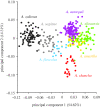Local variation and parallel evolution: morphological and genetic diversity across a species complex of neotropical crater lake cichlid fishes
- PMID: 20439280
- PMCID: PMC2871887
- DOI: 10.1098/rstb.2009.0271
Local variation and parallel evolution: morphological and genetic diversity across a species complex of neotropical crater lake cichlid fishes
Abstract
The polychromatic and trophically polymorphic Midas cichlid fish species complex (Amphilophus cf. citrinellus) is an excellent model system for studying the mechanisms of speciation and patterns of phenotypic diversification in allopatry and in sympatry. Here, we first review research to date on the species complex and the geological history of its habitat. We analyse body shape variation from all currently described species in the complex, sampled from six crater lakes (maximally 1.2-23.9 kyr old) and both great lakes in Nicaragua. We find that Midas cichlid populations in each lake have their own characteristic body shape. In lakes with multiple sympatric species of Midas cichlid, each species has a distinct body shape. Across the species complex, most body shape change relates to body depth, head, snout and mouth shape and caudal peduncle length. There is independent parallel evolution of an elongate limnetic species in at least two crater lakes. Mitochondrial genetic diversity is higher in crater lakes with multiple species. Midas cichlid species richness increases with the size and age of the crater lakes, though no such relationship exists for the other syntopic fishes. We suggest that crater lake Midas cichlids follow the predicted pattern of an adaptive radiation, with early divergence of each crater lake colonization, followed by intralacustrine diversification and speciation by ecological adaptation and sexual selection.
Figures










Similar articles
-
Rapid sympatric ecological differentiation of crater lake cichlid fishes within historic times.BMC Biol. 2010 May 12;8:60. doi: 10.1186/1741-7007-8-60. BMC Biol. 2010. PMID: 20459869 Free PMC article.
-
Genomic signatures of divergent selection and speciation patterns in a 'natural experiment', the young parallel radiations of Nicaraguan crater lake cichlid fishes.Mol Ecol. 2012 Oct;21(19):4770-86. doi: 10.1111/j.1365-294X.2012.05738.x. Epub 2012 Aug 30. Mol Ecol. 2012. PMID: 22934802
-
The Midas cichlid species complex: incipient sympatric speciation in Nicaraguan cichlid fishes?Mol Ecol. 2004 Jul;13(7):2061-76. doi: 10.1111/j.1365-294X.2004.02211.x. Mol Ecol. 2004. PMID: 15189226
-
Genomics of adaptation and speciation in cichlid fishes: recent advances and analyses in African and Neotropical lineages.Philos Trans R Soc Lond B Biol Sci. 2012 Feb 5;367(1587):385-94. doi: 10.1098/rstb.2011.0247. Philos Trans R Soc Lond B Biol Sci. 2012. PMID: 22201168 Free PMC article. Review.
-
African cichlid fish: a model system in adaptive radiation research.Proc Biol Sci. 2006 Aug 22;273(1597):1987-98. doi: 10.1098/rspb.2006.3539. Proc Biol Sci. 2006. PMID: 16846905 Free PMC article. Review.
Cited by
-
Quantifying (non)parallelism of gut microbial community change using multivariate vector analysis.Ecol Evol. 2022 Dec 28;12(12):e9674. doi: 10.1002/ece3.9674. eCollection 2022 Dec. Ecol Evol. 2022. PMID: 36590339 Free PMC article.
-
Heterospecific aggression bias towards a rarer colour morph.Proc Biol Sci. 2015 Sep 22;282(1815):20151551. doi: 10.1098/rspb.2015.1551. Proc Biol Sci. 2015. PMID: 26378216 Free PMC article.
-
Quantitative Analysis of Fish Morphology Through Landmark and Outline-based Geometric Morphometrics with Free Software.Bio Protoc. 2024 Oct 20;14(20):e5087. doi: 10.21769/BioProtoc.5087. eCollection 2024 Oct 20. Bio Protoc. 2024. PMID: 39512882 Free PMC article.
-
Crater lake cichlids individually specialize along the benthic-limnetic axis.Ecol Evol. 2014 Apr;4(7):1127-39. doi: 10.1002/ece3.1015. Epub 2014 Mar 7. Ecol Evol. 2014. PMID: 24772288 Free PMC article.
-
Form, function and phylogeny: comparative morphometrics of Lake Tanganyika's cichlid tribe Tropheini.Zool Scr. 2015 Jul;44(4):362-373. doi: 10.1111/zsc.12110. Epub 2015 Mar 10. Zool Scr. 2015. PMID: 27478295 Free PMC article.
References
-
- Adams D. C., Rohlf F. J., Slice D. E.2004Geometric morphometrics: ten years of progress following the ‘revolution’. Ital. J. Zool. 71, 5–16 (doi:10.1080/11250000409356545) - DOI
-
- Albrecht G. H.1980Multivariate analysis and the study of form, with special reference to canonical variate analysis 1. Integr. Comp. Biol. 20, 679–693 (doi:10.1093/icb/20.4.679) - DOI
-
- Altamiro G.1982Volcan Mombotombo Managua, Nicaragua: Instituto Nicaragüense de Estudios Territoriales; See http://www.ineter.gob.ni/geofisica/vol/momotombo/doc/altamirano1982.html
-
- Astorqui I.1971Peces de la cuenca de los grandes lagos de Nicaragua. Rev. Biol. Trop. 19, 7–57
-
- Barlow G. W.1973Competition between color morphs of the polychromatic Midas cichlid Cichlasoma citrinellum. Science 179, 806–807 (doi:10.1126/science.179.4075.806) - DOI - PubMed
Publication types
MeSH terms
Substances
LinkOut - more resources
Full Text Sources

